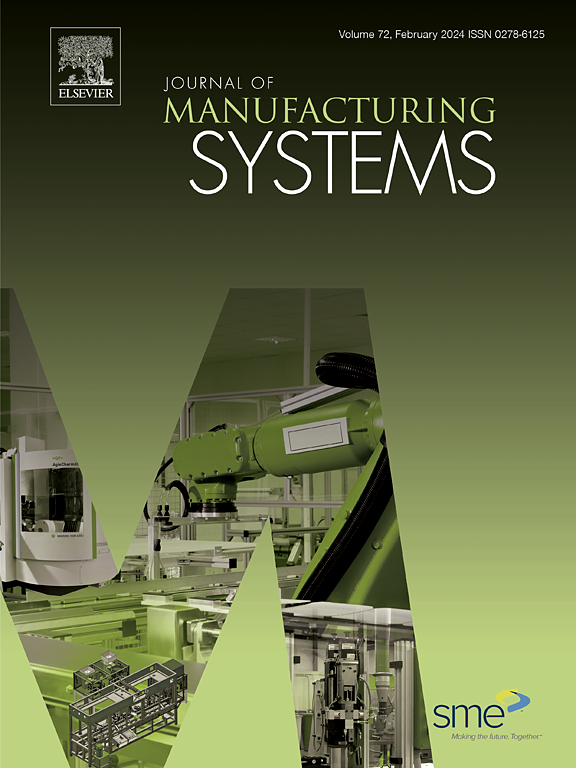Enhancing yield and process efficiency through dual internet of things and augmented reality for AI-driven human-machine interaction in centering mass production
IF 14.2
1区 工程技术
Q1 ENGINEERING, INDUSTRIAL
引用次数: 0
Abstract
With the emergence of smart manufacturing, artificial intelligence (AI) has become a pivotal technology for enhancing industrial process efficiency and production yield. By integrating data analysis methods, AI can effectively capture process characteristics during manufacturing. However, tasks such as setting machine parameters still rely heavily on human expertise. This study focused on the centering process of optical glass lenses as a case study. To minimize dependence on human expertise, establish real-time diagnostic mechanisms, and shorten calibration times, an intelligent human-machine interactive manufacturing system featuring a Dual Internet of Things (Dual-IoT) architecture and augmented reality (AR) technology was developed. This system employs a feature extraction model that combines root mean square (RMS) with exponentially weighted moving average (EWMA) to analyze time-series signals during processing. Subsequently, an echo state network (ESN) prediction model was established to accurately forecast real-time signals and identify anomalies. In this setup, the control system and AI model are interconnected through a Dual-IoT architecture, enabling real-time data transmission to the intelligent AR-based human-machine interaction system and remote monitoring interface. This setup enables the visualization of process diagnostics and decision-making, providing feedback to the centering machine through remote control mechanisms. According to the verification results, at target specifications of < 0.01 mm roundness and <E0.5 edge cracks, the proposed system enhanced production yield from 64 % to 94 % while reducing production time by 29.2 %. These results confirm the system’s effectiveness in augmenting industrial production processes.
通过双物联网和增强现实,实现人工智能驱动的大批量生产人机交互,提高产量和工艺效率
随着智能制造的出现,人工智能(AI)已成为提高工业流程效率和生产成品率的关键技术。通过集成数据分析方法,人工智能可以有效地捕捉制造过程中的过程特征。然而,诸如设置机器参数之类的任务仍然严重依赖于人类的专业知识。本研究以光学玻璃透镜的定心过程为个案进行研究。为了最大限度地减少对人类专业知识的依赖,建立实时诊断机制,缩短校准时间,开发了一种具有双物联网(Dual- iot)架构和增强现实(AR)技术的智能人机交互制造系统。该系统采用均方根(RMS)和指数加权移动平均(EWMA)相结合的特征提取模型对时间序列信号进行分析。随后,建立回声状态网络(ESN)预测模型,准确预测实时信号,识别异常。在此设置中,控制系统和AI模型通过双物联网架构互联,实现数据实时传输到基于ar的智能人机交互系统和远程监控界面。这种设置使过程诊断和决策可视化,通过远程控制机制向定心机提供反馈。验证结果表明,在圆度<; 0.01 mm和边缘裂纹<;E0.5 mm的目标规格下,该系统将生产良率从64 %提高到94 %,生产时间缩短29.2 %。这些结果证实了该系统在提高工业生产过程中的有效性。
本文章由计算机程序翻译,如有差异,请以英文原文为准。
求助全文
约1分钟内获得全文
求助全文
来源期刊

Journal of Manufacturing Systems
工程技术-工程:工业
CiteScore
23.30
自引率
13.20%
发文量
216
审稿时长
25 days
期刊介绍:
The Journal of Manufacturing Systems is dedicated to showcasing cutting-edge fundamental and applied research in manufacturing at the systems level. Encompassing products, equipment, people, information, control, and support functions, manufacturing systems play a pivotal role in the economical and competitive development, production, delivery, and total lifecycle of products, meeting market and societal needs.
With a commitment to publishing archival scholarly literature, the journal strives to advance the state of the art in manufacturing systems and foster innovation in crafting efficient, robust, and sustainable manufacturing systems. The focus extends from equipment-level considerations to the broader scope of the extended enterprise. The Journal welcomes research addressing challenges across various scales, including nano, micro, and macro-scale manufacturing, and spanning diverse sectors such as aerospace, automotive, energy, and medical device manufacturing.
 求助内容:
求助内容: 应助结果提醒方式:
应助结果提醒方式:


